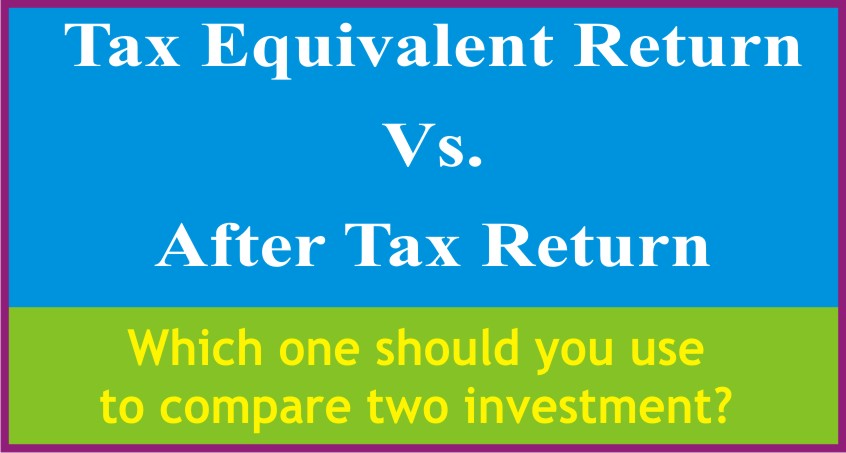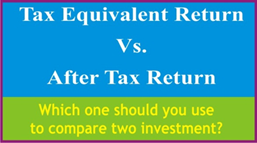Tax Equivalent Return Vs. After Tax Return
 Written by Sonal Sharma - Mon, 10 Mar 2025
Written by Sonal Sharma - Mon, 10 Mar 2025

Tax Equivalent Return Vs. After Tax Return

While evaluating taxable returns vs. tax-free returns, an investor needs to compare the numbers on common platform. The Tax-Equivalent Return formula can help an investor decide if a tax-free investment will give him a better return than a taxable investment.
Tax Equivalent Return: is the return an investor would have got after adding the tax benefit on a tax free return.
So,
Tax Equivalent Return = Tax Free Return(%) + Tax Benefit (%)
This Tax Benefit would depend on the Tax Slab an Investor falls into. That means two investors can look at the same Tax Free Investment but have different Tax Equivalent Returns if they fall into different Tax Brackets.
The higher the Tax Bracket of an Investor higher would be the Tax Equivalent Return.
After Tax Return: This the actual return an investor makes after deducting the tax on a taxable investment. Or it is the return net of taxes.
So,
After Tax Return= Stated Return (%) - Tax Outgo (%)
Formula and Examples of Tax Equivalent Return and After Tax Return
The Tax Equivalent Return formula states the tax-free return in terms of what an investor need to earn on a taxable investment to have the same return post taxes. The tax-equivalent return will be higher for investors in the higher tax brackets.
The tax equivalent return formula is used to compare the return between a tax-free investment and an investment that is taxed.
Tax-Equivalent Return = Tax-Free Interest Rate ÷ (1 – tax rate)
The After Tax Return is the actual return after adjusting the taxes to be paid on a taxable investment.
After Tax Return = Taxable Interest Rate × (1 – tax rate)
We will now highlight the difference between TER (Tax Equivalent Return) and (ATR) After Tax Return by an Example
Suppose an investor has the choice between two fixed-income options: A 6.50% taxable return or a 5.25% tax-free return. The Tax rate for the investor is assumed to be 30%.
So, now the question is which one of the two options should the investor choose?
We would use the formula of Tax-Equivalent Returns in order to arrive at a common comparison mode. The formula is:
Tax-Equivalent Return =
Putting the above figures in the formula:
=
=
= 7.50% =TER
This means that if the investor falls in the 30% tax bracket, then he needs to find a fixed income investment that yields AT LEAST 7.50% BEFORE TAX in order to get the same after-tax return of a 5.25% tax-free. In this case the investor would be in a much better position purchasing the tax-free option.
The same thing can be looked from another angle. We again assume that the investor falls in the tax bracket of 30% tax bracket and you find an investment with a taxable return of 7.50%. Since this return is taxable, the investor would not get to keep it all. So, a smart investor needs to calculate how much of that return is going to be left after taxes.
So, we can perform the following calculation, which is an alteration of the formula used above:
After Tax Return = Taxable Interest Rate × (1 – tax rate)
= 7.50 × (1 – .30)
= 7.50 × .70
= 5.25%
This is how both the concepts work
We can also calculate what the After-Tax Return is on the 6.50% return:
= 6.50 × (1 – .30)
= 6.50 × .70
= 4.55%
So which one out of 5.25% tax-free or 4.55% tax-free would be chosen by an investor is an easy question to be answered.
What needs to be noted is that the higher the tax bracket of an investor, the more advantageous a Tax-free return becomes for him. We can have a look at the graphic to illustrate the same concept:
|
Tax Bracket |
Tax Free Return |
Tax Equivalent Return |
|
10% |
5.25% |
5.83% |
|
15% |
5.25% |
6.18% |
|
20% |
5.25% |
6.56% |
|
25% |
5.25% |
7.00% |
|
30% |
5.25% |
7.50% |
|
35% |
5.25% |
8.08% |

Can we compare a Tax Equivalent Return and After Tax Return to judge which is better investment?
The answer is no.
We can compare a Tax Equivalent Return to a Stated Before Tax Return.
We can compare a Tax Free Return with an After Tax Return
Therefore it is very important for investors to understand the meaning of Tax Equivalent Return and After Tax Return and the comparison between two returns can be made only before the tax considerations or after tax considerations. Also because difference in Tax Slabs what may look good for a high-income investor in higher tax bracket may not necessarily be good for lower income investor in lower tax bracket.
Author by
Comments (0)
Search
Popular categories
Wealth Management
7Finance
7Financial Planning
6Finance Certifications
4Investing
3Financial Statements
2Latest blogs

Discover the Power of a Private Family Trust in India!
Sat, 15 Mar 2025 0 285

9 Surprising Things You Should Never Include in Your Will (And What to Do Instead)
Sat, 15 Mar 2025 0 204

Why Indian Investors Are Flocking to Factor-Based Passive Funds?
Sat, 15 Mar 2025 0 201
Write a public review